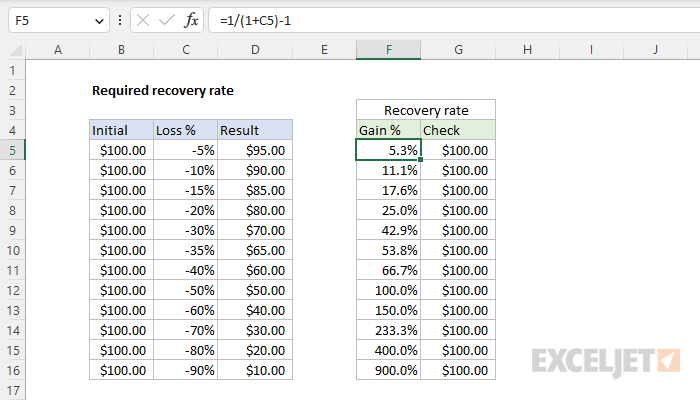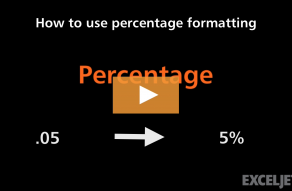Explanation
In this example, the goal is to calculate the required recovery rate (or gain) to complete offset a loss expressed as a negative percentage. This is not a difficult problem, but you must pay attention to the sign of the loss and be sure to format the result with the percentage number format.
Background
One of the most important aspects of investing is the math of gains and losses. A 50% loss does not require a 50% gain to recover the loss, it actually requires a 100% gain. Put simply, as a loss gets larger (as a percentage), the recovery rate (or gain), required to offset the loss increases at an increasing rate:
- A loss of 10% requires a gain of 11.1%
- A loss of 20% requires a gain of 25%
- A loss of 50% requires a gain of 100%
- A loss of 80% requires a gain of 400%
Formula
With a loss expressed as a percentage, you can calculate the required gain or recovery rate with a formula like this:
=1/(1-%loss)-1
The formula above assumes the loss is given as a positive percentage. If the loss is given as a negative percentage (as in the worksheet shown), use the modified formula below:
=1/(1+%loss)-1
In the worksheet shown, the loss percentages are in column C. The formula in F5, copied down, is:
=1/(1+C5)-1
This formula evaluates like this:
=1/(1+-0.05)-1
=1/(0.95)-1
=1.0526-1
=0.0526
=5.3%
The result is a decimal value that should be formatted with the percentage number format.
Formula check
To check the calculated recovery rate for each loss, the formula in G5, copied down, is:
=D5*(1+F5)
This formula simply multiples the result in column D by 1 plus the recovery rate. In all cases, it should return the initial value in column B, proving that the recovery rate will completely offset the loss.












